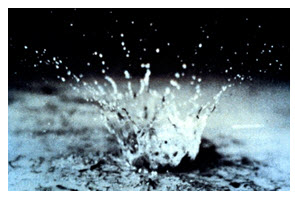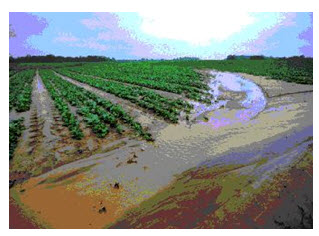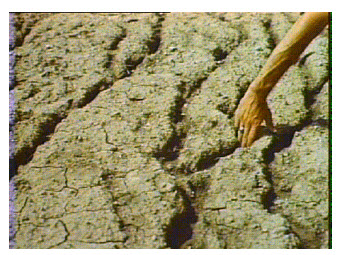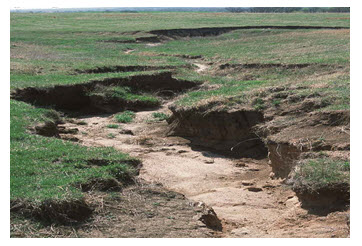Site pages
Current course
Participants
General
Module 1: Formation of Gully and Ravine
Module 2: Hydrological Parameters Related to Soil ...
Module 3: Soil Erosion Processes and Estimation
Module 4: Vegetative and Structural Measures for E...
Keywords
Lesson 5 Mechanism of Erosion
5.1 Introduction
The soil erosion may be defined as detachment, transportation and deposition of soil particles from one place to another place under influence of wind, water and gravity forces (Suresh, R., 2002). Erosion of soil by water is caused by its two forms- liquid as flowing water, and solid as the glaciers. The impact of rainfall causes splash erosion. Runoff water causes scraping and transport of soil particles leading first to sheet erosion, followed by rill erosion and lastly to gully erosion. Water waves cause erosion of bank sides of reservoirs, lakes and oceans. The sub-surface runoff causes soil erosion in the form of pipe erosion. The glacial erosion causes heavy landslides. In India, glacial erosions are mainly confined to Himalayan regions.
5.2 Mechanics of Water Erosion
(1) Raindrop Erosion
Raindrop erosion is soil detachment and transport resulting from the impact of water drops directly on soil particles or on thin water surfaces. The impact of raindrops breaks the soil crust and splashes the soil particles away. Fig. 5.1 shows the raindrop impact. The mass of each raindrop is directly proportional to its kinetic energy. Wischmeier and Smith (1978) gave the following equation for the calculation of K.E.

Where,
E = kinetic energy of raindrop (MJ/ha-mm),
I = rainfall intensity (mm/hr).

Fig. 5.1. Raindrop impact (splash). (Source: http//utexas.edu)
Erosivity of Rainfall
The potential ability of rain to cause erosion is called erosivity of rainfall. Erosivity is expressed by EI30 index. Using rainfall and soil loss information from experimental plots Weischmeier et al. (1958) concluded that best estimator of soil loss is a compound parameter, the product of kinetic energy of the storm and the maximum intensity of storm during a continuous period of 30 minute.
The EI30 index was developed under American condition and it is reported not to be very accurate under tropical and subtropical conditions. An alternate method was developed to describe the erosivity of rainfall. This is based on concept that low intensities of rainfall cause no erosion and there is a threshold value of intensity at which rain starts to become erosive. Experimental evidence confirmed this concept and it was observed that rainfall intensities less than 25 mm/h have not resulted in significant erosion. The index for erosivity as KE > 25, indicating that the total kinetic energy of the rain falling at intensities greater than 25 mm/h is considered as erosive.
(2) Sheet erosion
Sheet erosion of soil is a conceptual or an idealized form of soil erosion, where the fertile top soil is removed in uniform layers under the action of runoff water or the overland flow. Such type of removal of the top soil in the form of a layer or a sheet is very difficult to visualize. Sheet erosion is affected by flow velocity, flow volume, and physical and chemical properties of soil, etc. In reality, the sheet flow is carried out by very small definable channels called the inter-rills. Raindrop detaches very thin layers of soil particles through splash and the detached particles are then carried through the inter-rills by a very thin layer of the overland flow. The soil erosion by inter-rills is dependent on the erosion that takes place through rills. Fig. 5.2 shows sheet erosion.

Fig. 5.2. Sheet erosion. (Source: http//plantandsoil.unl.edu)
(3) Rill Erosion
Prolonged occurrence of soil erosion through inter-rills, results widening of the inter-rills and formation small channels, called rills. Fig. 5.3 shows the rill erosion.

Fig. 5.3. Rill erosion. (Source: http// milford.nserl.purdue.edu)
These rills carry both the overland flow from the inter-rill areas and the direct flow. In a channeled flow, the depth of flow is more, thus soil erosion is very high from the well-defined channels. Rills carry the sediment brought by the overland flow through its inter-rills, and have a controlling effect on the magnitude of soil erosion.
(4) Gully Erosion
Rills are small in size and can be smoothened by tillage operations. When rills get larger in size and shape due to prolonged occurrence of flow through them and cannot be removed by tillage operations, these are called gullies. Fig. 5.4 shows the gully erosion. Large gullies and their networks are called ravines. Some of the major causes of gully erosion are steepness of land slope, soil texture, rainfall intensity, land mismanagement, biotic interference with natural vegetation, incorrect agricultural practices, etc. Gully erosion gets initiated where the longitudinal profile of an alluvial land becomes too steep due to sediment deposition.

Fig. 5.4. Gully erosion. (Source: http// passel.unl.edu)
Gullies advance due to the removal of soil by flowing water at the base of a steep slope. High intensity of flow or the runoff increases the gully dimensions.
(5) Stream Channel Erosion
The tractive force of the flow of water in a drainage channel scours the bed and cuts the soil from its sides. The removal and transportation of soil, in such situations, occurs in three stages: (i) suspension, (ii) saltation, and (iii) surface creep, depending on the physical properties of the soil particles and the flow parameters of the runoff water, namely turbulence, soil particle size, particle distribution, sediment cohesiveness, and specific gravity of the sediment. Poor alignment and the presence of obstructions such as sandbars increase meandering, the major cause of erosion along the bank.
5.3 Factors Inducing Water Erosion
The major variables affecting soil erosion are climate, soil, vegetation, and topography. Of these, vegetation and, to some extent, soil and topography may be controlled. The climatic factors are beyond the power of human being to control.
(i) Climate
Climatic factors affecting erosion are precipitation, temperature, wind, humidity, and solar radiation. Temperature and wind are the most evident through their effects on evaporation and transpiration. However, wind also changes the raindrop velocities and the angle of impact. Humidity and solar radiation are somewhat less directly involved in that they are associated with temperature and the rate of soil water depletion.
(ii) Soil
Physical properties of soil affect the infiltration capacity and the extent to which particles can be detached and transported. In general, soil detachability increases as the size of the soil particles or aggregates increase, and soil transportability increases with a decrease in the particle or aggregate size. That is, clay particles are more difficult to detach than sand, but clay is more easily transported. The properties that influence erosion include soil structure, texture, organic matter, water content, clay mineralogy, and density or compactness, as well as chemical and biological characteristics of the soil.
(iii) Vegetation
The major effect of vegetation in reducing erosion are (1) interception of rainfall by absorbing the energy of raindrops and thus reducing surface sealing and runoff, (2) retardation of erosion by decreased surface velocity, (3) physical restraint of soil movement, (4) improvement of aggregation and porosity of the soil by roots and plant residue, (5) increased biological activity in the soil, and (6) transpiration, which decreases soil water, resulting in increased storage capacity and less runoff.
(iv) Topography
Topographic features that influence erosion are degree of slope, shape and length of slope, and size and shape of the watershed. On steep slopes, runoff water is more erosive, and can more easily transport detached sediment down the slope. On longer slopes, an increased accumulation of overland flow tends to increase rill erosion. Concave slopes, with lower slopes at the foot of the hill, are less erosive than convex slopes.
5.4 Mechanics of Wind Erosion
Wind erosion is the detachment and transport of soil particles by the forces of moving wind. Wind erosion is caused by mismanagement of land resources, such as intensive farming, over grazing, deforestation, etc. These practices destroy the cohesive properties of soil particles and make them susceptible to wind erosion. Wind erosion process may be divided into three phases: (1) initiation of movement, (2) transportation, and (3) deposition.
(i) Initiation of Movement
Soil movement is initiated as a result of turbulence and velocity of wind. The fluid threshold velocity is defined as the minimum velocity required producing soil movement by direct action of wind, whereas the impact threshold velocity is the minimum velocity required to initiate movement from the impact of soil particles carried in saltation. Except very near the surface and at low velocities (less than about 1m/s), the surface wind is always turbulent. Wind speeds of 5 m/s or less at 0.3 m height are usually considered non-erosive for mineral soils.
(ii) Transportation
The quantity of soil moved is influenced by the particle size, gradation of particles, wind velocity, and distance across the eroding area. Wind, being variable in velocity and direction, produce gusts with eddies and cross currents that lift and transport soils. The quantity of soil moved varies as the cube of the excess wind velocity above the constant threshold velocity, the square root of the particle diameter, and the gradation of soil. The rate of the soil movement increases with the distance from the windward edge of the field or eroded area.
(iii) Deposition
Deposition of sediments occurs when the gravitational force is greater than the forces holding the particles in the air. The process generally occurs when there is a decrease in wind velocity caused by vegetation or other physical barriers, such as ditches, vegetation and snow fences.
5.5 Factors Inducing Wind Erosion
The major factors affecting wind erosion at any location are climate, soil, and vegetation.
(i) Climate
The climatic factors that influence wind erosion are the characteristics of wind itself in addition to the precipitation, humidity and temperature. The climatic factors influence the soil moisture status which in turn influences the susceptibility of the soil for erosion by wind.
(ii) Soil
Textures, structure, density of particles, organic matter content are the soil characteristics that influence erosion by wind. Soil moisture content and surface roughness are the other factors which have an impotent bearing on wind erosion. Soil moisture content is important as relatively dry soil is subject to wind erosion. Surface crusts when formed have a retarding influence on wind erosion.
(iii) Vegetation
Vegetation influences wind erosion, directly when the area is under vegetation or indirectly by protecting the adjoining areas. Type of vegetation, its height, density and seasonal distribution are the factors influencing wind erosion.